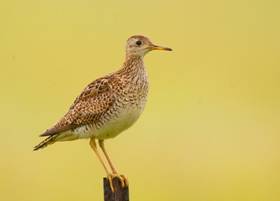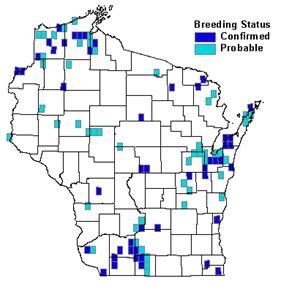

Status/Protection
- Global Rank: G5 Key to global and state ranks
- State Rank: S2B
- WBCI Priority: SGCN, PIF, State Special Concern
Population Information
The Federal BBS information can be obtained at http://www.mbr-pwrc.usgs.gov/bbs/bbs.html by clicking on Trend Estimates and selecting the species in question. All estimates are for time period (1966-2005).
- Federal Breeding Bird Survey: non-significant increase
- Federal Breeding Bird Survey (WI): significant decline
- Federal Breeding Bird Survey (BCR 23): significant decline
- Federal Breeding Bird Survey (BCR 12): non-significant increase
- WSO Checklist Project: significant decline (1983-2007)
Life History
- Breeding Range: Southern Canada south to central U.S., from Rocky Mountains east to Appalachian Mountains (Houston 2001).
- Breeding Habitat: Pasture, Hay, Idle Cool-season Grasses, Dry Prairie, Dry-mesic Prairie, Pine Barrens, Sand Barrens.
- Nest: Ground.
- Nesting Dates: May-June.
- Foraging: Ground Glean.
- Migrant Status: Neotropical.
- Habitat use during Migration: ag fields, grasslands.
- Arrival Dates: Mid-late April-May.
- Departure Dates: July-September.
- Winter Range: South America east of Andes Mountains from Surinam and northern Brazil south to Pampas region of Argentina, Paraguay and Uruguay.
- Winter Habitat: pampas, grassland, agricultural fields.
Habitat Selection
Upland Sandpipers prefer dry grasslands with low to moderate forb cover, low woody cover, moderate amounts of residual vegetation and litter, and little bare ground (Sample and Mossman 1997). Vegetation is usually 4-16 inches high and avoids tall dense vegetation (Houston 2001). Commonly used habitats in Wisconsin include lightly grazed pastures, old fields, idle grasslands, barrens, large dry forest clearcuts, dry prairie, and hay fields. Loafing and brood-rearing habitats include heavily grazed pasture, hayfields, fallow fields, and row crops (Sample and Mossman 1997).
Upland Sandpipers are highly area-sensitive requiring grassland patch sizes >30 ha in size (DeChant et al. 2003). Densities of Upland Sandpipers were positively correlated with patch area and inversely correlated with perimeter:area ratios (DeChant et al. 2003).
Habitat Availability
Barrens, idle grasslands, old fields, fallow fields, and pastures large enough to attract Upland Sandpipers (UPSA) are rare and subject to fragmentation, especially on private agricultural lands that UPSA is attracted to (Sample and Mossman 1997). Conversion of pasture and fallow fields to row crops and the growth of trees in fence lines has lowered the available habitat on private lands. With the UPSA’s preference for large habitat areas (>100 ac), few to no shrubs, and shorter vegetation height (< 3 ft) public lands managed for medium to large scale upland grasslands, such as Crex Meadows, Liberty Grove Grasslands, Yellowstone/Pecatonica River Grasslands and Savannas, and the Military Ridge Prairie Heritage Area are the most suitable habitat for harboring a viable population of UPSAs (Sample & Mossman 1997).
Population Concerns
The UPSA was once a common breeder in the continental US, Canada, and Alaska. Market hunting, egg collecting, and its use as target practice in the nineteenth and early twentieth century coupled with the loss of suitable habitat has brought a significant decline to this species outside the Great Plains (Houston 2001). Fragmentation of large blocks of grassland and conversion of pastures and fallow fields to row crops has limited the suitable habitat for the UPSA.
Population declines in Wisconsin are some of the largest of any portion of this species’ range. Declines in Wisconsin are largely due to the loss and intensification of agricultural grasslands. Without large blocks of idle and/or grazed grasslands the UPSA may disappear from Wisconsin (Sample 2002).
Recommended Management
Grassland/barrens restorations and management should focus on large blocks of habitat (>100ha) as UPSA densities have been shown to correlate with patch size (DeChant et al. 2003). Blocks of grassland should be within 1.6km of each other and be contiguous with other grassy habitats (DeChant et al. 2003).
Site-level management for UPSA should provide short-medium height vegetation with moderate amounts of litter, residual vegetation, and grass:forb ratio (Sample and Mossman 1997). Patches of trees or wooded fencelines should be removed to provide necessary open space. Larger grassland units should provide a range of successional stages or ag types to provide both nesting and brooding cover within the site (DeChant et al. 2003).
Research Needs
Territory size/requirements for successful rearing of young, effect of landscape context, and the importance of proximity to other breeding Upland Sandpipers. More information on the importance of pastures and proper stocking rates and pasture management for this and other grassland species.
Information Sources
- North American Breeding Bird Survey: USGS Patuxent Wildlife Research Center
- Effects of Management Practices on Grassland Birds: Upland Sandpiper
- Managing Habitat for Grassland Birds: A Guide for Wisconsin
- Robbins, S. D., Jr. 1991. Wisconsin birdlife: Population and distribution past and present. Madison, WI: Univ. Wisconsin Press.
- David Sample, Grassland Community Ecologist, Wisconsin DNR Research Center, 1350 Femrite Dr., Monona, WI 53716.
- James Hoefler, Wildlife Biologist, WI DNR. Crex Meadows Headquarters, PO Box 367, Grantsburg, WI 54840.
- Gene Tiser, Naturalist.WI DNR, NER Headquarters, 1125 N Military Ave., Green Bay, WI 54307.
- Gregory Pittz, Yellowstone Team Supervisor, WI DNR, Yellowstone Lake, 7896 Lake Rd., Blanchardville, WI 53516.
References
- Dechant, J. A., M. F. Dinkins, D. H. Johnson, L. D. Igl, C. M. Goldade, B. D. Parkin, and B. R. Euliss. 2003. Effects of management practices on grassland birds: Upland Sandpiper. Northern Prairie Wildlife Research Center, Jamestown, ND. Northern Prairie Wildlife Research Center Online. http://www.npwrc.usgs.gov/resource/literatr/grasbird/upsa/upsa.htm (Version 12DEC2003).
- Houston, C. S. 2001. Upland Sandpiper (Bartramia longicauda). In the Birds of North America, No. 580 (A. Poole and F. Gill eds.). The Birds of North America, Inc., Philadelphia, PA.
- Sample, D. 2002. Upland Sandpiper. In Atlas of the Breeding Birds of Wisconsin (N.J. Cutright, B.R Harriman, and R.W Howe, eds.). Wisconsin Society of Ornithology, Inc. 602pp.
- Sample, D. and M. Mossman. 1997. Managing Habitat for Grassland Birds: A guide for Wisconsin. Wisconsin Department of Natural Resources: Madison, WI.
- Wisconsin Breeding Bird Atlas: http://www.uwgb.edu/birds/wbba/
Contact Information
- Compiler: Jenny Herrmann, mherrmann4@wi.rr.com
- Editor: Rich Henderson, WI-DNR, richard.henderson@dnr.state.wi.us
